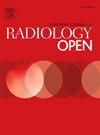Low KV-low contrast medium dose one-stop dual source CT high pitch integrated coronary-carotid-cerebral-aortic CTA improves image quality and reduces both radiation and contrast medium doses
IF 1.8
Q3 RADIOLOGY, NUCLEAR MEDICINE & MEDICAL IMAGING
引用次数: 0
Abstract
Rationale and objectives
To evaluate the impact of low dose-low contrast medium injection protocol on radiation dose and image quality of one-stop dual source high pitch integrated coronary -carotid -cerebral- aortic CTA.
Methods
A total of 211 non-obese patients, consisting of 44 females with an average age of 59 years, were split into two groups: low dose group (LD group n = 136) and routine dose group (RD group n = 75). Noise, attenuation, signal to noise ratio (SNR), and contrast to noise ratio (CNR) were compared between the groups by setting region of interest (ROI) in target vessels to evaluate objective image quality. Two radiologists assessed subjective image quality using the 5-point scale. volumetric CT dose index (CTDIvol), dose length production (DLP), and effective radiation dose (ED) were compared, while contrast medium (CM) dose was assessed by CM volume and iodine uptake (IU).
Results
Both radiation and CM dose were significantly reduced in the LD group compared with the RD group, DLP and ED were reduced by 51 %, and CM volume and IU were reduced by 13 % (all p < 0.05). Attenuation and noise were higher, while SNR and CNR were close to or slightly higher in the LD group compared with the RD group. The LD group had higher subjective image quality scores while all scores in the two groups satisfied the diagnostic requirements.
Conclusion
Low-kV, low-CM one-stop dual-source high-pitch integrated coronary-carotid-cerebral-aortic CTA can ensure image quality while significantly reducing the doses of contrast medium and radiation
低kv -低造影剂剂量一站式双源CT高音高一体化冠-颈-脑-主动脉CTA提高图像质量,降低辐射和造影剂剂量
目的探讨低剂量-低造影剂注射方案对一站式双源高音高综合冠状动脉-颈动脉-脑主动脉CTA放射剂量和图像质量的影响。方法211例非肥胖患者,女性44例,平均年龄59岁,随机分为低剂量组(LD组n = 136)和常规剂量组(RD组n = 75)。通过设定目标血管的感兴趣区域(ROI),比较各组间的噪声、衰减、信噪比(SNR)和噪比(CNR),评价客观图像质量。两名放射科医生使用5分制评估主观图像质量。对比体积CT剂量指数(CTDIvol)、剂量长度产生(DLP)和有效辐射剂量(ED),对比造影剂(CM)剂量通过CM体积和碘摄取(IU)评估。结果与RD组相比,LD组放疗和CM剂量均显著降低,DLP和ED减少51 %,CM体积和IU减少13 % (p均为 <; 0.05)。与RD组相比,LD组的衰减和噪声更高,而信噪比和CNR接近或略高。LD组主观影像质量评分较高,两组均满足诊断要求。结论低kv、低cm一站式双源高音高一体化冠-颈-脑-主动脉CTA在保证图像质量的同时,可显著降低造影剂剂量和辐射剂量
本文章由计算机程序翻译,如有差异,请以英文原文为准。
求助全文
约1分钟内获得全文
求助全文
来源期刊

European Journal of Radiology Open
Medicine-Radiology, Nuclear Medicine and Imaging
CiteScore
4.10
自引率
5.00%
发文量
55
审稿时长
51 days
 求助内容:
求助内容: 应助结果提醒方式:
应助结果提醒方式:


